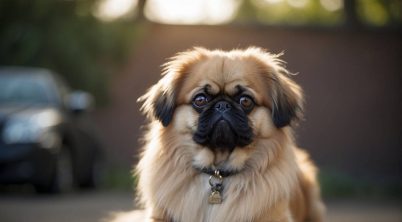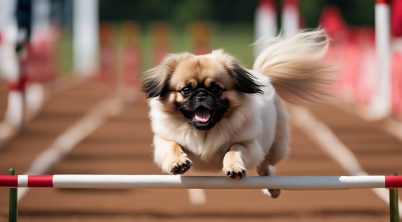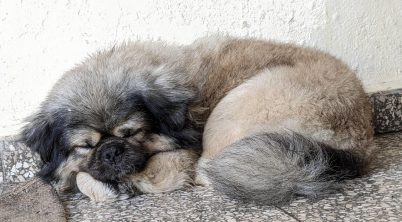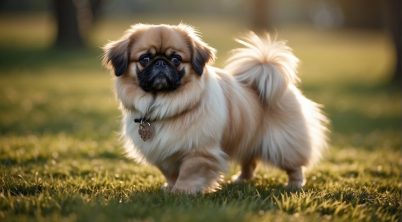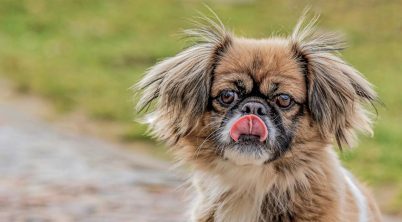Pekingese dogs often engage in licking behavior as an expression of their affection and a means to bond with their owners. This small toy breed, cherished for its friendly disposition, uses licking as a social interaction that signifies trust and love. Licking is a behavior rooted in their early life experiences where mother dogs groom their puppies, which not only cleans and comforts them but also strengthens their bond. For a Pekingese, licking their owner’s face can be seen as an extension of this grooming behavior, meant to display affection and establish a social connection.
Moreover, when Pekingese dogs lick their paws excessively, it is important to consider that this behavior might stem from underlying health issues such as allergies. Allergens in the environment, like pollen or dust, or sensitivities to certain foods, can cause discomfort leading to persistent licking and biting at their paws. Observing a Pekingese’s behavior and context can provide insight into why they lick so much and whether their licking is a sign of contentment and bonding or an indication of a health concern that needs to be addressed.
Why Do Pekingese Lick So Much?
Pekingese dogs may often be seen licking their owners, themselves, or even objects around the home. This behavior is typically an expression of affection or a natural grooming habit. Affectionate licking is a dog’s way of showing love and building a bond with their owner. When a Pekingese licks a human’s face, they are expressing trust and comfort. It originates from a maternal instinct, as mother dogs often lick their puppies to clean them and stimulate their reflexes.
Licking can also be a sign of submission. Within a pack, a dog may lick another to acknowledge their higher status. Pekingese, with their social nature, may exhibit this behavior with both humans and other pets to maintain harmony.
Another common reason a Pekingese might lick is due to licking paws because of allergies. Allergic reactions can urge the dog to lick or bite their paws to alleviate irritation. Potential allergens include:
- Pollen
- Dust mites
- Certain foods
To understand why a specific Pekingese licks excessively, it’s fundamental to observe the context and frequency of the behavior. Owners should check for any signs of discomfort, such as swollen paws or red skin, which might indicate an underlying health issue. If the licking is focused on paws and is persistent, seeking veterinary advice is recommended to rule out allergies or other medical concerns.
Pekingese Temperament
The Pekingese breed is known for its confident and independent temperament, often commanding a presence far larger than their small stature. They are loyal companions that exhibit a calm demeanor but with an underlying dignified stubbornness.
Companionship and Loyalty
The Pekingese is exceptionally loyal to their family, often forming a strong, unbreakable bond with their owners. They thrive on attention and affection, demonstrating their devotion through constant companionship. It’s not uncommon for a Pekingese to follow their owner throughout the house, seeking to be involved in daily activities.
Independence and Stubbornness
Despite their small size, Pekingese are known for their independent spirit and may display a level of stubbornness. Training a Pekingese requires patience as they are intelligent dogs, but they like to do things on their terms. This independent streak is part of their dignified personality often resembling the demeanor of the lion dog, the nickname they’ve earned through their mane-like appearance and bold nature.
Interaction with Children and Pets
Pekingese can be calm and polite around children, but due to their small size and preference for a tranquil environment, they are better suited for households with older children who understand how to interact with dogs gently. When it comes to other pets, Pekingese generally coexist peacefully, as long as these pets respect their authoritative dignity and personal space.
Behavioral Traits
The Pekingese breed exhibits distinct behavioral traits, including affectionate tendencies, possessiveness over food and toys, and particular licking and grooming habits. These behaviors reflect their complex social interactions and emotional responses.
Affectionate Tendencies
The Pekingese is known to express its affection openly. These dogs tend to show their love for their owners through close physical contact, such as cuddling and nuzzling. They may also lick their owners as a sign of affection, resembling the grooming behavior seen in their wild ancestors.
Guarding Food and Toys
A Pekingese can be quite possessive when it comes to their possessions, including food and toys. This guarding behavior is a natural instinct, as they may feel the need to protect their resources. Owners should be mindful to approach training with patience to manage these possessive traits effectively.
Licking and Grooming Behavior
Licking is a characteristic behavior in Pekingese and can be attributed to various factors:
- Affection: As a sign of love and to reinforce bonds.
- Grooming: Licking can be a self-cleaning habit, a part of their natural grooming process.
- Stress or Anxiety: Excessive licking might indicate underlying stress or anxiety that the dog is experiencing.
Careful observation of context and frequency can help determine the cause of a dog’s licking behavior and whether it is a matter of affection, grooming, or a signal of discomfort.
Physical and Health Characteristics
The Pekingese, a toy breed, is compact and weighs up to 14 pounds, with a height range of 6-9 inches. Their physical build is unmistakable with a characteristic flat face or brachycephalic skull. This feature, while distinctive, predisposes them to certain health problems such as Brachycephalic Airway Obstruction Syndrome (BAOS), which can lead to breathing difficulties. Regular monitoring by a veterinarian is advisable to manage and mitigate potential respiratory issues.
Exercise is essential for the Pekingese, albeit they have low energy levels and their activity requirements are modest. Given their size and propensity for a sedentary lifestyle, they are prone to obesity. It’s vital to maintain a healthy weight through controlled diet and regular, but gentle, exercise.
In terms of health, the Pekingese breed can be susceptible to specific conditions. They often face eye problems due to their prominent eyes, which are at risk of ulceration or prolapse. Dental disease is also a common issue in small breeds like the Pekingese, making dental care an essential part of their routine. Though less common, they can suffer from hip dysplasia; hence, breeders should conduct proper health screenings.
| Health Aspect | Characteristic |
|---|---|
| Size | Small |
| Brachycephalic Nature | Pronounced |
| Tendency to Health Issues | High |
| Risk of Obesity | Elevated |
| Exercise Requirements | Low |
| Energy Levels | Typically Low |
Appropriate care, including regular veterinary check-ups and attention to their unique needs, helps ensure the breed’s well-being. The Pekingese’s lion-like mane further requires regular grooming to avoid matting and to maintain overall health.
Pekingese Grooming Needs
The Pekingese is a breed that commands attention not just for its confident demeanor but for its distinctive, lush coat that requires diligent care. Regular grooming is necessary to maintain the health and appearance of a Pekingese’s coat.
Daily Brushing: They need daily brushing to prevent their long coats from matting. A slicker brush is ideal to gently work through the fur, starting from the head and moving down the body. Regular brushing also helps to reduce shedding by removing loose hairs.
| Frequency | Tools Required | Purpose |
|---|---|---|
| Daily | Slicker brush, Comb | Prevent matting, reduce shedding |
| Weekly | Ear cleaning solution, Cotton balls | Monitor and maintain ear health |
Owners should be vigilant for signs of allergies or skin infections, which Pekingese can be prone to. Excessive licking or biting of the paws may indicate an allergic reaction. Allergies can result from various environmental factors such as pollen, dust, or food sensitivities.
Incorporating fish oil supplements might be beneficial, as they contain omega-3 fatty acids that promote healthy skin and coat. Consultation with a vet can determine the appropriate dosage for individual needs.
| Supplement | Benefit |
|---|---|
| Fish oil | Healthier skin, less prone to allergies/skin infections |
To summarize, Pekingese grooming needs revolve around regular brushing, vigilance towards skin health, and appropriate supplementation to support coat and skin condition. Owners must commit to this routine to ensure their Pekingese’s majestic mane remains in regal condition.
Training and Socialization
Effective training and socialization are indispensable for Pekingese due to their sometimes stubborn nature and significant need for proper behavior shaping. These elements help curb excessive licking and other potentially problematic behaviors.
Training Techniques for Stubborn Breeds
Pekingese, often characterized by their independent disposition, can exhibit a reluctance to follow commands, which calls for consistent and strategic training techniques. Positive reinforcement stands out as a powerful tool where they receive rewards like treats or praise when they respond correctly or abstain from unwelcome actions, such as excessive licking. A clear and consistent training regimen should be established, and professional dog trainers can be invaluable, especially for first-time owners unfamiliar with the breed’s temperament.
- Identify Triggers: Determine what prompts the licking behavior.
- Redirect Attention: Use commands such as ‘sit’ or ‘stay’ to refocus their behavior.
- Consistent Commands: Maintain a set of clear cues for desired behavior.
- Rewards: Provide treats and affection for compliance and calmness.
Importance of Early Socialization
Early socialization is crucial in a Pekingese’s life; it equips them with the skills to interact appropriately with humans and other animals. This experience reduces stress-induced behaviors such as licking when encountering new situations or beings. Puppies should be exposed to a variety of environments, people, and fellow pets under monitored, safe conditions. Obedience classes not only aid in teaching the basic commands but also facilitate controlled social exposure critical for a well-mannered Pekingese.
- Enroll in Puppy Classes: Introduce to structured settings for learning and interaction.
- Schedule Playdates: Regularly meet with other dogs to build social skills.
- Diverse Environments: Take the Pekingese to different places to expand comfort zones.
- Gentle Exposure: Introduce new experiences gradually to avoid overwhelm.
Through focused training and diverse socialization efforts, Pekingese can develop into well-adjusted pets, less likely to resort to constant licking as a behavioral response.
Caring for a Pekingese
When caring for a Pekingese, understanding their unique requirements and characteristics is crucial. By establishing a daily routine, meeting their social needs through play, and considering their environmental space, owners can ensure a happy and healthy dog.
Daily Activities and Routines
A Pekingese thrives on a consistent daily routine. They require regular grooming due to their long coat and facial structure. Owners should clean their face folds at least twice daily to prevent infection. When it comes to exercise, two 20-minute walks per day are beneficial for their health. These dogs can be stubborn, so patience during leash training is essential.
- Morning: A brisk walk and face cleaning.
- Evening: Another walk followed by grooming sessions.
Social Needs and Interactive Play
Pekingese are affectionate dogs who enjoy engaging with their family. While they may not require extensive exercise, they love interactive play. This includes activities like fetch, which can be done indoors or outdoors. Offering interactive toys can also keep them mentally stimulated, especially when they are alone.
- Playtime: Incorporate sessions of fetch and hide and seek.
- Toys: Provide a variety of toys like puzzle feeders to challenge them.
Environment and Space Considerations
This breed doesn’t need a vast amount of space, making them suitable for apartment living. However, owners should ensure that the living environment is comfortable for the dog, with areas designated for rest, play, and feeding. Clean, safe, and cozy spaces make a Pekingese feel secure and content.
- Rest: A soft bed in a quiet corner.
- Space: Enough room for movement and playtime without hazards.
Pekingese in Popular Culture
The Pekingese, an ancient Chinese breed, has long been a symbol of status and cultural significance, and its presence has left a mark on various facets of popular culture, from mythology to modern media.
Historic and Modern Popularity
Historical Significance:
- Ancient Times: The Pekingese is one of the oldest dog breeds, often associated with the Chinese imperial family. They were considered sacred and symbolic of the ancient Chinese culture.
- The Titanic Link: Notably, a Pekingese named Sun Yat-Sen was one of the three dogs to survive the Titanic disaster, emphasizing the breed’s historical prominence among the elite.
Modern-Day Popularity:
- Lap Dogs and Companions: Their historical role as lap dogs for royalty has transitioned well into modern times, where they are often seen as affectionate companions.
- Toy Group Classification: In dog shows, the Pekingese is part of the Toy Group, a category for small and lovable lap dogs, which has solidified their status in canine competitions.
Cultural Representation:
- Throughout time, the breed has been represented in art, literature, and in the homes of noteworthy individuals, maintaining the Pekingese’s status as both a cultural icon and a beloved pet.

